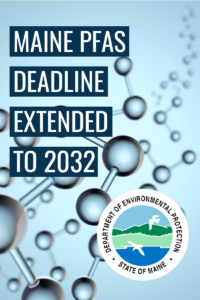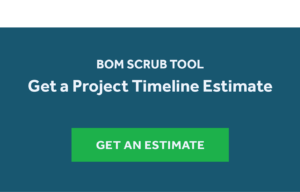PFAS
May 3, 2024 | Written by GreenSoft Technology, Inc.
Major Changes to Maine PFAS Regulation; Deadline Extended to 2032
 Maine PFAS regulation amended: revised notification requirements and prohibition deadlines
Maine PFAS regulation amended: revised notification requirements and prohibition deadlines
On April 16, the Governor of Maine signed a new amendment to the state’s PFAS regulation bringing about crucial changes that directly impact electronics manufacturers.
Among other changes, the January 1, 2025 reporting requirement for all products sold in Maine has been eliminated, while maintaining prohibitions on PFAS usage. Additionally, the prohibition deadline has been extended from January 1, 2030 to January 1, 2032 for most products (including consumer electronics). However, the notification requirement is still in place for products or specific uses which have been granted an unavoidable use determination by the Maine Department of Environmental Protection (DEP).
The details of the requirements and ban on the sale of any products sold in the state of Maine which contain intentionally added perfluoroalkyl and polyfluoroalkyl substances (PFAS) substances, are outlined below.
General Prohibition: Starting January 1, 2032, companies will not be able to sell, offer for sale, or distribute to sell any product containing intentionally-added PFAS in the state of Maine unless exempted due to product category or unavoidable use as noted below. Previously the effective date for this prohibition was January 1, 2030.
Alternative Product Category Deadlines: Some products have different deadlines than stated above. The prohibition deadline for carpets, rugs, and fabric treatments became effective as of January 1, 2023. The prohibition deadline for cleaning products, cookware, cosmetics, dental floss, juvenile products, menstrual products, ski wax, and upholstered furniture becomes effective as of January 1, 2026. The prohibition deadline for artificial turf and outdoor apparel for severe wet conditions is effective January 1, 2029. Finally, the prohibition deadline for cooling, heating, ventilation, air conditioning and refrigeration equipment, including parts and other servicing needs for such equipment, and refrigerants, foams and aerosol propellants comes into effect on January 1, 2040.
Product Category Exemptions: Semiconductors, non-consumer electronics (electronic devices not used for personal, family, or household purposes), non-consumer laboratory equipment, medical devices, veterinary products, water testing products, products required to meet various federal transportation/aviation/defense standards, motor vehicles, watercrafts, firefighting foams, and equipment used to produce the aforementioned categories of products are exempted from the prohibition and may continue to use intentionally-added PFAS in their products.
Unavoidable Use Exemption: Products containing intentionally-added PFAS which have been granted an unavoidable use determination by the DEP, are exempt from the prohibition requirements for a period of 5 years from the determination date or prohibition date. Instead, they are subject to the reporting requirements of the regulation, effective as of the unavoidable use determination by DEP.
Small Business Exemption: Manufacturers that employ 100 or fewer people are exempt from the notification requirements of the regulation. Previously the small business exemption was for manufacturers employing 25 or fewer people.
Notification Requirement: Manufacturers subject to unavoidable use determinations must notify the DEP if they sell, offer for sale, or distribute to sell any product containing intentionally-added PFAS. The notification must include, among other information, a brief description of the product, the purpose for which PFAS are used in the product, the amount and identification of each of the PFAS, and identification of the specific unavoidable use determination applied. Previously the effective date for notification requirements was January 1, 2025, and the previous notification requirements applied to all products containing intentionally-added PFAS rather than just products that have been granted an unavoidable use determination.
The full text of the regulation and the amendment can be found online. GreenSoft Technology’s summary of the original regulation requirements can be found on our blog. And our PFAS Resource Center provides additional articles and videos on PFAS regulations around the globe.
Implications for Minnesota's PFAS regulation
The amendments to Maine's PFAS regulation not only impact affected businesses but also raise questions about the fate of similar regulations in other states. Given the close alignment between Maine's and Minnesota's PFAS regulations, the changes introduce a layer of uncertainty regarding Minnesota's stance on PFAS regulation.
Electronics manufacturers and industry stakeholders await clarity on whether Minnesota will follow suit and amend its regulation in alignment with Maine's changes or maintain its original framework. However, currently there is no indication Minnesota plans to adopt similar changes to their PFAS in products requirements. Learn more about Minnesota’s PFAS regulation here.
GreenSoft Technology offers a PFAS solution for manufacturers
GreenSoft Technology provides companies with a Data Services solution to help with the Maine and Minnesota PFAS regulations, EPA TSCA Section 8(a)(7) PFAS reporting and recordkeeping requirements, as well as other emerging and proposed PFAS regulations around the globe.
Our data collection team will contact your suppliers to obtain data on the substances contained in your product and components. We’ll validate that data for accuracy and completeness, and then check it against the U.S. EPA’s Master List of PFAS Chemicals, as well as any other global environmental regulations you must comply with.
With our Turnkey Service, we can generate the necessary compliance reports for you. Or you can use our GreenData Manager software to manage your company’s substance database and generate reports for this and other environmental regulations.
Contact us to learn more.





